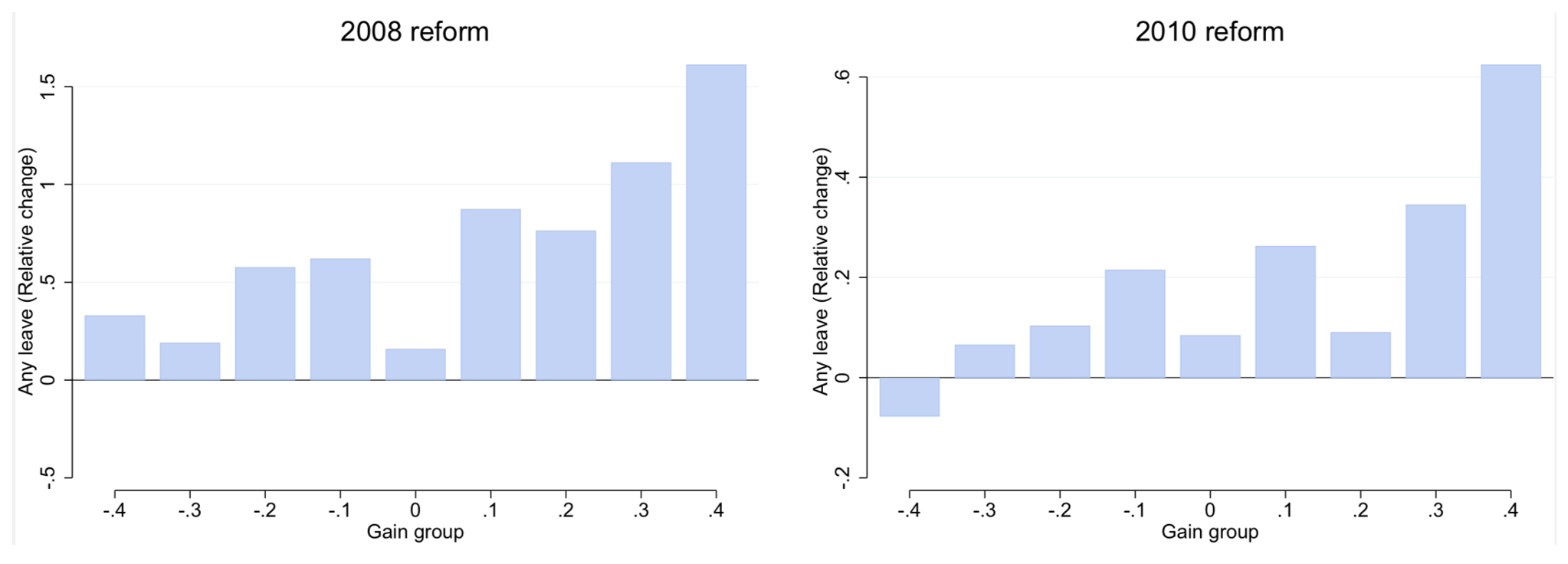Although parental leave policies increasingly encourage the involvement of both parents, only some fathers take time off work to take care of their children. According to recent statistics from the OECD Family Database, men account for just 20% of parents going on leave, and this share is mainly driven by the Nordic countries.
At the same time, there is a large body of evidence showing the benefits, for parents and children, of higher paternal involvement in child-rearing. Children benefit from paternity leave because the increased presence of the father improves their social, behavioural, and psychological outcomes (Sarkadi et al. 2008) and increases school performance (Cools et al. 2015). Paternity leave can also positively affect life satisfaction of both mothers and fathers (Van Lent and Korsgren 2022).
Another advantage is that the burden of early childcare is more evenly split between women and men. When fathers go on leave, mothers can return to the labour market earlier. Paternity leave might also increase fathers’ involvement in childcare and household chores beyond the leave spell, allowing mothers to work longer hours or accept jobs that do not allow for much flexibility.
Recent evidence shows that much of the prevailing gender differences in labour market outcomes are connected to child-rearing. Earnings of mothers drop substantially after the birth of a child and remain lower in subsequent years, while earnings of fathers are hardly affected (Kleven, Landais and Søgaard 2018, Klevin, Landais, Posch et al. 2019).
To design future leave policies more effectively, it is crucial to understand why fathers rarely choose to go on leave. One potential explanation for low take-up rates is financial considerations of families in which the parents have different income levels. If men earn substantially more than women, paternity leave entails a temporary yet significant drop in family income. Although fathers would like to go on leave, they might not do so to avoid the associated earnings loss. This choice exacerbates the gender earnings gaps that open up after the birth of a child.
Another reason for the low take-up could be the lack of flexibility in parental leave schemes. Fathers might be willing to take a few months of parental leave but may shy away from it if the shortest available option lasts longer.
Financial incentives and flexibility of leave schemes
In a recent paper (Ziegler and Bamieh 2023), we study the relative importance of financial concerns and flexibility considerations for the leave decisions of fathers. Would men take more paternity leave if they were better compensated for income losses or if leave schemes offered shorter options? We empirically test these hypotheses by examining two recent parental leave reforms in Austria.
Before 2008, the only available leave scheme paid a flat benefit rate for 36 months. Parents who wanted shorter leave had to forgo benefit payments for the remaining months. The first reform, enacted in 2008, introduced much shorter parental leave options while keeping the total amount of parental leave benefits on a similar level.
In 2010, a second reform further increased flexibility and introduced income-dependent parental leave benefits, considerably raising income replacement rates for higher-earning parents. The new scheme replaced 80% of the parent’s previous net earnings but offered at least €1,000 and at most €2,000 in monthly benefits to leave-taking parents.
We combine the analysis of these two reforms to disentangle the impact of flexibility and financial incentives. While the first reform made parental leave substantially more flexible, the second reform added financial incentives for specific income groups and increased flexibility only marginally. Comparing changes induced by the two reforms allows us to evaluate the relative importance of both factors.
To quantify the impact on leave choices, we combine population-wide administrative records on childbirths with data on parental leave benefits and employment spells in Austria. Our analysis shows that each reform increased the share of fathers going on leave by about 10–20% compared to take-up rates measured in earlier years.
Because both reforms offered shorter leave schemes but only the second reform raised monetary incentives, the findings suggest that flexibility considerations are more important than financial concerns in explaining take-up rates.
Contrary to the positive effects on take-up, we estimate decreases in paternity leave months conditional on taking leave: the availability of new schemes made more fathers go on leave, but they increasingly chose shorter leave options. Overall the share of leave months taken up by fathers remained similar, confirming that increased flexibility was the key driver of higher take-up rates.
Leave choices and household earnings differences
The decision to take parental leave is a joint household decision, trading off benefits and costs of both spouses. This is particularly important within the Austrian setting because parents have to choose a common leave scheme together and the leave share reserved for each parent is only about one-sixth. Given the option of income-dependent benefits, gender earnings gaps within the family should play an important role in this decision.
A central question is whether leave benefits can sufficiently compensate for the earnings loss while the parent is on leave and cannot earn income from work. If financial considerations prevented some fathers to take leave before 2010, we would expect that high-earning fathers with low-earning spouses react most to the introduction of income-dependent benefits.
To show how the new scheme affects household income in families with different earnings levels, we compute family-specific income replacement rates assuming that either the father or the mother goes on leave. The replacement rate is defined as the ratio between family income after childbirth (parental leave benefits and earnings of the second parent) and family income before childbirth.
For most families, the introduction of income-dependent benefits substantially increased their potential income replacement rate. Because fathers often have higher earnings, this increase was, on average, higher when the father instead of the mother decided to take parental leave.
If financial considerations matter for leave decisions of fathers, we expect stronger reform effects for families with larger potential gains. To test this empirically, we divide fathers into gain groups, which indicate by how much the replacement rate increases due to the reform if the father instead of the mother takes leave. This relative gain is positive if the father has higher earnings and negative if the mother earns more.
Figure 1 shows how the two reforms affected paternity leave take-up in the different gain groups. Consistent with our predictions, the effects of the 2010 reform tend to be larger for higher gain groups, in which financial incentives for paternity leave are stronger. Yet, we observe a similar pattern two years earlier, when the 2008 reform was enacted and all gain groups benefited equally from the availability of shorter leave options.
Figure 1 Impact on paternity leave take-up by potential gain in family income replacement rate
Although the income-dependent scheme was not available yet, fathers were still more likely to increase leave take-up if they earned more than their spouses. This comparison suggests that more generous benefits cannot explain why fathers in families with high income gaps respond more to the new schemes.
Using supplementary survey data, we show that couples in which men earn more adhere to much more conservative gender and family views than couples with similar income levels. The observed changes in take-up suggest that conservative families are more likely to require more flexible options to consider paternity leave, whereas progressive families less often base their decisions on scheme availability.
Taking all evidence together, our study results indicate that many fathers want to go on leave but only for short periods. In fact, the introduced changes increased take-up rates while actual leave duration declined. As a result, childcare duties remain very unevenly split between mothers and fathers, and more generous parental leave benefits appear to have limited scope to change that.
References
Cools, S, J H Fiva, and L J Kirkebøen (2015), “Causal effects of paternity leave on children and parents”, Scandinavian Journal of Economics 117(3): 801–28.
Kleven, H, C Landais, J Posch, A Steinhauer, and J Zweimüller (2019), “Child penalties across countries: Evidence and explanations”, VoxEU.org, 14 May.
Kleven, H, C Landais, and J E Søgaard (2018), “Children and gender inequality: Evidence from Denmark”, VoxEU.org, 12 July.
Sarkadi, A, R Kristiansson, F Oberklaid, and S Bremberg (2008), “Fathers’ involvement and children’s developmental outcomes: A systematic review of longitudinal studies”, Acta Paediatrica 97(2): 153–58.
Van Lent, M, and P Korsgren (2022), “Earmarked paternity leave increases parental wellbeing”, VoxEU.org, 19 February.
Ziegler, L, and O Bamieh (2023), “What drives paternity leave: Financial incentives or flexibility?”, IZA Discussion Paper.




